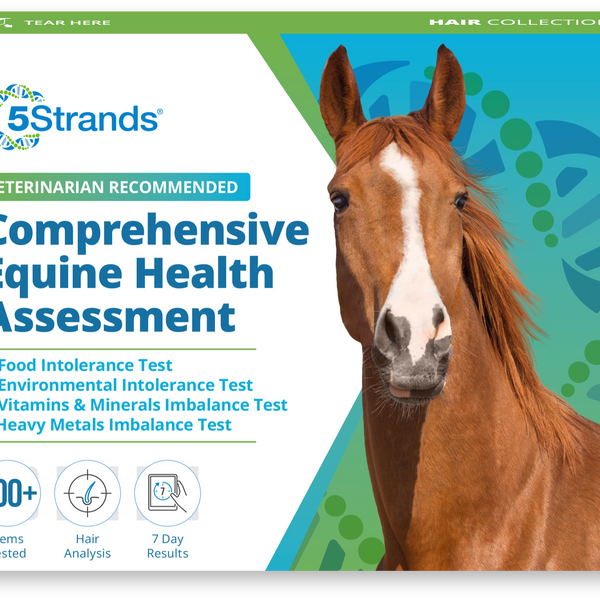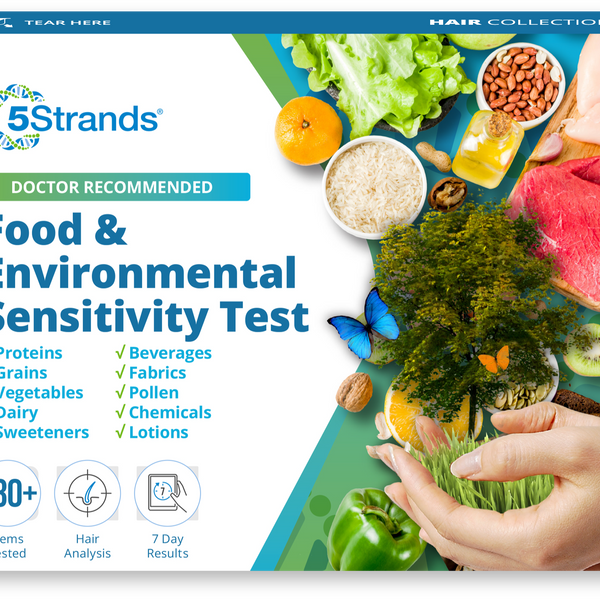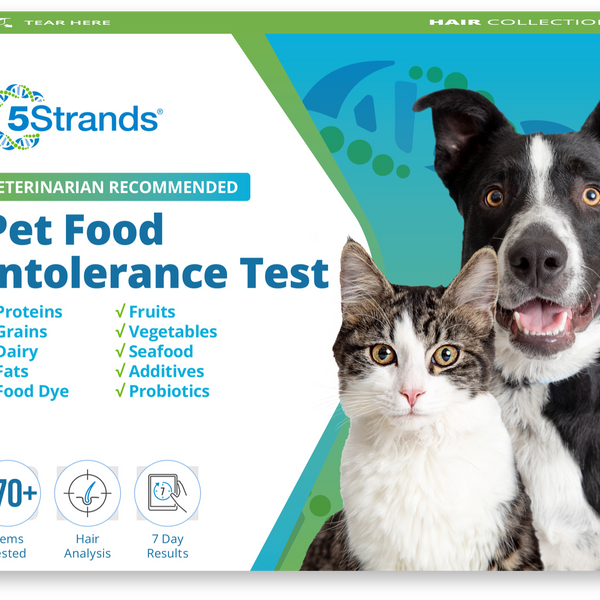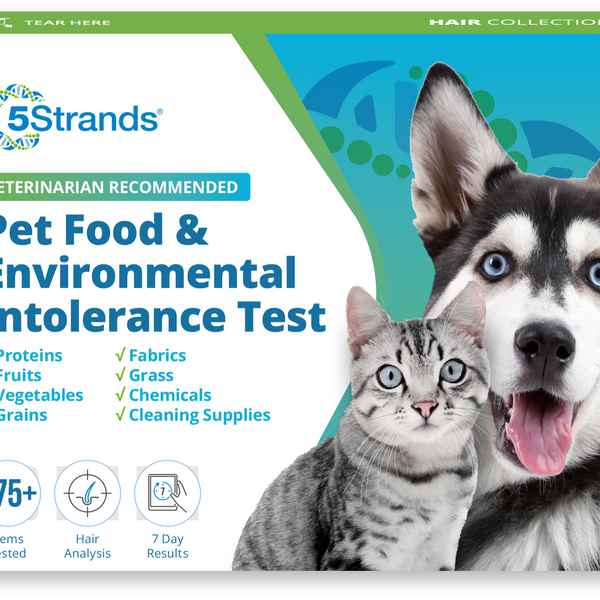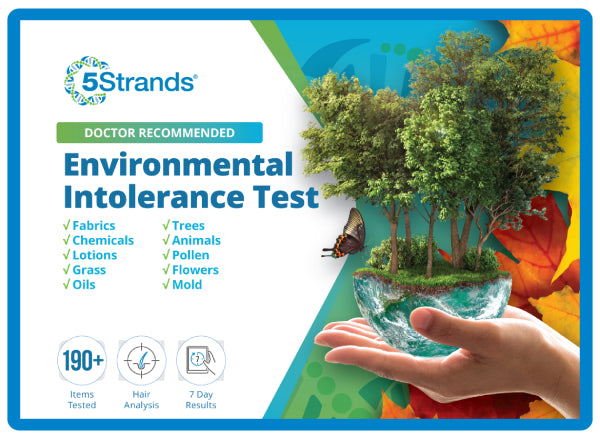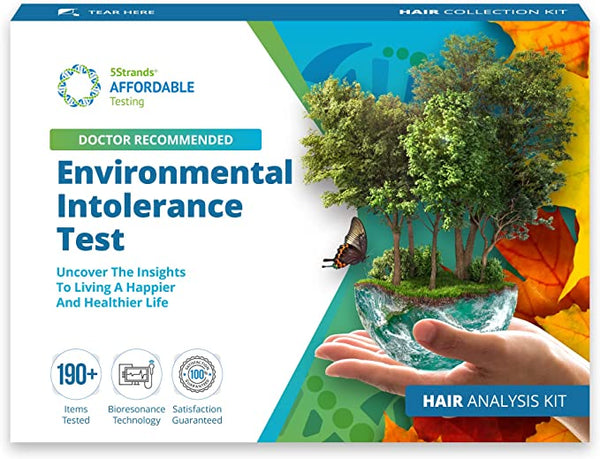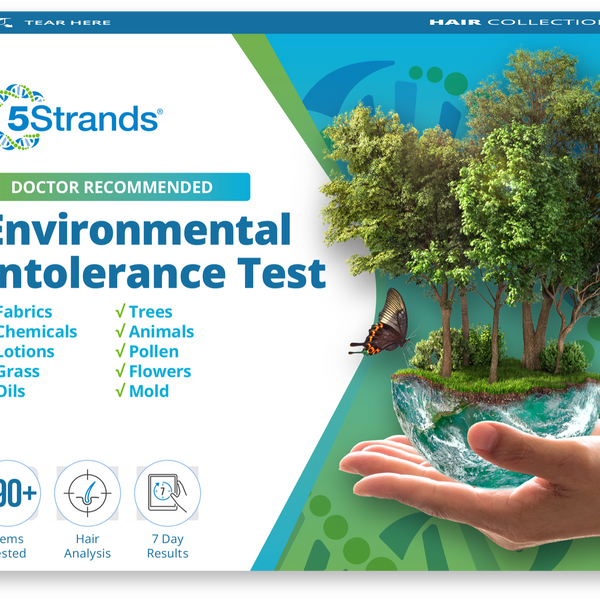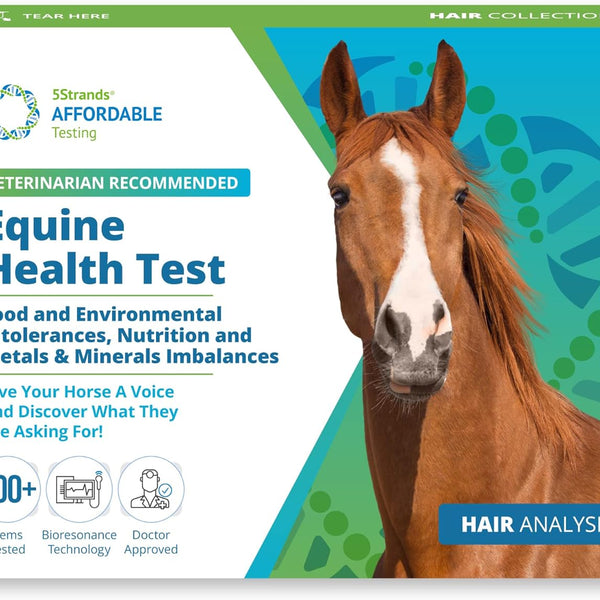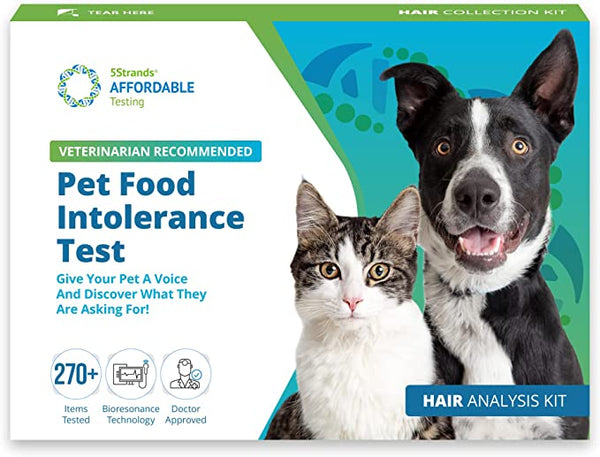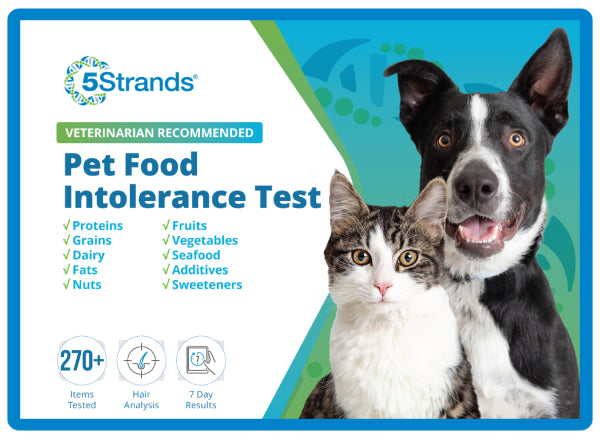Do you think your dog might be allergic or intolerant to something? It can be tough to distinguish between dog allergies and dog intolerances. This blog post will discuss the symptoms, explain how vets test for dog allergies, and explain the differences between allergens and intolerances. If your dog is not suffering from allergies, it might be an intolerance. 5Strands Affordable Testing offers dog intolerance testing so that you can get to the bottom of your pup's troubles!
Allergy and Intolerance Symptoms
The symptoms your dog will experience for allergies and intolerances will overlap. The biggest differences are:
- Allergy symptoms are more immediate while intolerances can be delayed (12-72 hours).
- Allergic responses can be life threatening while intolerances are not.
- Allergies involve the immune system while intolerances do not.
Face:
- Red face, hair loss around ears, repetitive scratching and sneezing
Paws:
- Inflammation and discoloration, irritation between paws, hot spots, excessive licks, and gnawing
Ears:
- Excessive scratching of the area, waxing, yeast infections, rubbing the area against furniture, sores inside the ear
Haircoat:
- Balding patches, odors, discoloration, excessive and repetitive licking of specific areas
Skin:
- Redness, Dryness, scaly, repetitive licking of specific areas, trembling

Dogs can have allergic/intolerant reactions to food, environmental stimuli, or both.
Food allergies are caused by the dog's immune system reacting to a particular substance in their food. Most often it is the protein in the food. If it is a food issue, the symptoms will be year round.
Environmental allergies are caused by the dog's immune system reacting to something in the environment, such as pollen, dust mites, or mold. Typically with environmental issues, the symptoms are seasonal.
Food intolerances are typically caused due to the lack of digestive enzymes to break a food item down or an overconsumption issue. It does not involve the immune system therefore they can change.
Solving Food Allergies and Intolerances | Traditional Allergy Testing
Short-term food restriction - A food trial is the best way to diagnose a food allergy or intolerance. The dog is fed a novel protein diet for 12 weeks. If the dog's symptoms resolve, the dog was likely allergic or intolerant to something in their previous diet. After 12 weeks on a limited diet, you can then re-introduce the old food to confirm. If the symptoms begin again, then you know it was the food. The problem with this method is now you have to begin all over again with the elimination plan.
A hydrolyzed diet is where the protein source is broken down into tiny pieces that the immune system should not react to daily. This diet might work well in determining a food allergy but not a food intolerance since the intolerance does not involve the immune system. This diet is highly digestible, completely balanced nutritionally, and can be utilized for long-term feeding. The downside to this diet is that it is usually much more costly, some pets do not like the taste, and there is still a possibility of an allergic reaction. Most of the hydrolyzed diets will still contain additives, preservatives, and synthetic vitamins/minerals. Dogs can be intolerant to these items so this diet is not good for dogs with intolerances.
No matter which option you choose, you must remember that you only feed your dog the suggested food; this means no treats, no table food, no flavored medications, etc. Even the tiniest table scrap or flavored medication could ruin the test. Every member of your household must be on the same page, or this will not work!
While dog food allergies and Intolerances are not as common as some other pet allergies, they can still pose a severe threat to your dog's health. If you think your dog may be allergic or intolerant to their food, take them to the vet for a proper diagnosis. In the meantime, there are a few things you can do to help ease the symptoms.
How to begin an elimination diet for your dog
Step 1: Begin With a 50/50 Diet
If you think your dog may have a food allergy or intolerance, the best way is to put them on a staged elimination diet. Elimination diets involve slowly removing all potential triggers from their diet and then reintroducing them one at a time to see if there's a reaction.
If your dog has been diagnosed with an intolerance or allergy, consider switching to dog food made with limited ingredients. Limited ingredient dog foods are made with a single protein source and a single carbohydrate source, making it easier to identify which ingredients your dog is allergic or intolerant to.
Skin issues should see signs of improvement after about 4-8 weeks. If your dog is still having issues after eight weeks, it may not be experiencing symptoms from food. This step is considered complete when all clinical symptoms have been resolved.
Step 2: Observe and Take Notes
You will want to journal your dogs' dietary intake and any changes in their symptoms and behaviors during step 1. This will help you and your vet to identify if there are any potential food allergies or intolerance. Be sure to take note of what type of dog food you are feeding them and how much and how often. If you have more than one dog, it is essential to keep track of which ones are eating which foods.

Step 3: Reintroduction Process
Once your dog has completed the elimination period and its symptoms have improved, you will want to begin introducing its previous diet again. If your dog starts exhibiting symptoms once again, you have confirmed the food issue.
Step 4: Confirm
You will now have to restart the initial elimination diet now that you have confirmed that your dog has a food sensitivity. This time, you will need to be more vigilant in your efforts. Keep a close eye on any changes in your dog's energy levels, stool, and skin condition. If you notice any adverse reactions, discontinue the use of that food immediately. However, your pet should start to see improvement once again within a few short weeks.
Step 5: Identify and Craft a Safe and Healthy Diet for Your Pet
Now that you know which foods to avoid, it's time to create a safe and healthy diet for your dog. This may require trial and error, but eventually, you will find the perfect combination of ingredients that work for your dog.
You will start out with one food at a time. Feed your pet the food item and then wait and see how they respond. If they do not exhibit any symptoms, you can continue that food but in moderation.
What if the elimination trial fails?
If you do not see any change in your dogs' symptoms after the expected period, several factors may have contributed to the failure.
Contamination during food production.
Many foods are prepared in commercial kitchens where other ingredients are readily available. Cross-contamination can occur during production if ingredients and surfaces are not always adequately sanitized during the production process. A dog with food allergies may be sensitive to a protein or other ingredient transferred to the food during production.
Contamination during food handling and transport.
Once food leaves the commercial kitchen, there is potential for contamination during food handling. For example, if someone preparing your dog's food is also handling foods that contain ingredients your dog is allergic to, there is room for error that may influence your dog's reaction to consumption. It is essential to always sanitize all surfaces and feeding plates or bowls before placing food into them.
Environmental Exposure to Allergens

If your pet did not have any change in their symptoms during the elimination period, it may not be the food that they are being triggered by. Suppose a dog has regular environmental exposure to the outdoors or rooms in your house with plants, not from the local environment. In that case, the dog can be triggered by the surroundings or inhaled during day-to-day activities. If a dog is triggered by the inhaled pollen, the dog may be intolerant to the environment. If a dog is intolerant to the environment, the dog may be itchy, sneeze, or have watery eyes. The dog may also experience difficulty breathing.
If a dog experiences these symptoms, it is essential to let your veterinarian know about these symptoms and environmental surroundings. Your dog may also benefit from modifications to its surroundings, medications, or other treatments to help cope with the environment.
Your vet may want to rule out other potential causes. They may perform a thorough physical examination and then may recommend other testing. The testing could include skin scraping, surface cytology, hair pluck exam, fungal cultures, blood, and urine testing, chemistry panels, thyroid hormone testing, and urinalysis.
You and your vet can do several tests to determine if your dog has allergies and intolerances. A skin allergy test, also called an intradermal test, best diagnoses environmental allergies. Environmental allergies are an immune response to something in your surroundings that's typically otherwise harmless, like pollen, mold, or dust mites.
What if there was an easy way to give yourself a guideline to follow? A guide that takes all the guesswork out of this process.
5Strands Affordable Testing has created a simple at-home hair analysis test using bio-resonance technology to determine the food items that your dog may have an intolerance to. This is information that you cannot get from a blood test. The dog's hair holds all of the information about what they have been ingesting and how their body reacts. The results will give you a list of ingredients to avoid feeding your dog to keep them healthy and happy.
The 5Strands Pet Food test will test your pet against over 255 food ingredients found in most commercially prepared foods. It will include proteins, grains, fruits, vegetables, seafood, additives, preservatives, food colorings, and flavorings. If your dog is found to have an intolerance to any of the items found, you will be provided with a list of the items to avoid. This test is essential for dogs experiencing chronic digestive issues, skin problems, or other health problems that their diet could cause.
Simple tests result straight from our lab right to your door

In one simple test, you will receive a report that will indicate all of the items your dog showed a response to and all of the items they did not respond to. This test is essential because it can help determine what ingredients are best to avoid in your dog's food. You will be able to conduct an elimination diet without any guesswork. You will then be able to start reintroducing foods right after the elimination period.
There is no need to spend weeks trying to figure out what you can and can not feed your furry friend! 5Strands testing results will save you so much time, energy, and money. This way, you can ensure that your dog gets the best nutrition possible.
The test is simple. You collect a small sample of your dog's hair, register the unique ID number in your kit, and send the hair sample in the prepaid postage/envelope to our lab. Once the sample has been received, wait 5-7 days for the results.
If your dog has food intolerances, don't worry. With a little bit of investigation and this test, you will be able to find the best food for your pup. No more guessing or trial and error! Test today and get started on the path to a healthier tomorrow for your dog. Click here to order your kit now.
If the elimination guideline is overwhelming for you, 5Strands also has a Certified Pet Nutritionist on staff. You can call and consult with them.
They have partnered with Tazz Latifi, a specialist in the pet food industry, home-cooked diets & recipes, raw diets, supplements, and natural pet industry brands. Tazz offers 5Strands customers personalized consultations at a nominal fee to assist pet owners with specific recommendations on manipulating the pet's diet safely and healthily. Dog owners who think their dog may have an intolerance or allergy should contact Tazz Latifi. She will be able to help you determine if your dog has a food intolerance or food allergy and make recommendations on how to move forward. Don't let your dog suffer needlessly, contact Tazz today!
After reading this, we hope you and your furry friend will be able to frolic together again, happily and more often! Please share this with a friend if a friend of furry you know would benefit from the same knowledge!

